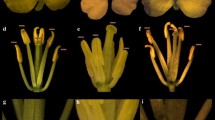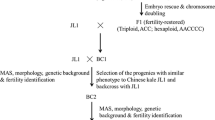Summary
Strong indication was found for the existence of a chromosal monogenic dominant male sterility-gene in chenese cabbage. This source of male sterility can be of practical use for the production of hybrid varieties. A pronounced drawback is the required removal, in the breeding and seed production stage, of the approximately 50% male fertile plants from each offspring of male sterile plants. Fortunately this removal is facilitated by the penomenon of apical dominace in the flowering process in the whole Brassica rapa taxon. Moreover an advantage of dominant monogenic male sterility is its easy and rapid introduction into all available genotypes of chinese cabbage.
Similar content being viewed by others
References
Ferguson, J.H.A., 1956. Some applications of binomial probability paper in genetic analyses. Euphytica 5: 329–338.
Hinata, K. & N., Konno, 1979. Studies on a male sterile strain having the Brassica campestris nucleus and the Diplotaxis muralis cytoplasm. I. On the breeding procedure and some characteristics of the male sterile strain. Japan. J. Breed. 29: 305–311. English summary.
Jambhale, N. D. & Y. S., Nerkar, 1985. An Induced Dominant Gene Controlling Male Sterility in Safflower. Z. Pflanzenzüchtung 95: 185–188.
Leung, H. & W. P., Williams, 1983. Cytoplasmic Male Sterile Brassica campestris Breeding Lines with Resistance to Clubroot, Turnip Mosaic, and Downy Mildew. Hortscience 18 (5): 774–775.
Leung, H., Xin-Ke, Niu, E. H., Erickson & P. H., Williams, 1983. Selection and genetics of nectary development in cytoplasmic male sterile Brassica campestris. J. Amer. Soc. Hort. Sci. 108: 702–706.
Ohkawa, Y., 1984. Cytoplasmic male sterility in Brassica campestris spp. rapifera. Japan. J. Breed. 34: 285–294.
WeaverJr., T. B. & T., Ashley, 1971. Analysis of a dominant gene for male sterility in upland cotton, Gossypium hirsutum L. Crop Sci. 11: 596–598.
Wei, S. L. & Z. Y., Zhu, 1981. Selection of dual-purpose male sterile/maintainer lines of Chinese cabbage. Pl. Br. Abstr. 52, 1982: 6065.
Williams, P. H. & F. W. Heyn, 1981. The origin and development of cytoplasmic male sterile Chinese cabbage. p. 293–300. In: N. S. Talekar and T. D. Griggs (eds.) Proc. First Intern. Symp. on Chinese Cabbage, Asian Vegetable Research and Development Center, Tainan, Taiwan.
Author information
Authors and Affiliations
Rights and permissions
About this article
Cite this article
van der Meer, Q.P. Chromosomal monogenic dominant male sterility in chinese cabbage (Brassica rapa supbs. pekinensis (Lour.) hanelt). Euphytica 36, 927–931 (1987). https://doi.org/10.1007/BF00051877
Received:
Accepted:
Issue Date:
DOI: https://doi.org/10.1007/BF00051877




